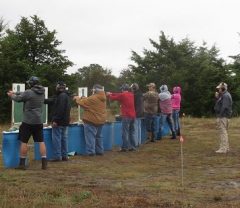Firearms training, pistol training, and related disciplines, are like embracing any other skill; it requires an organized approach, study, and setting both long-term and short-term goals. For some people, goal setting is a nebulous, “touchy-feely” part of the process, but in fact, it’s a very pragmatic step.
If, like many people, you are learning to shoot a handgun to protect your family from a home invasion, then you would want to be able to hit the bad guy at a distance of at least 10 yards. Why would you think that accuracy at 3 yards is sufficient? Especially given that the FBI, and all law enforcement sources, estimate that, under crisis pressure, the average shooter only performs at 50% of his/her skill level. In fact, according to the FBI, police officers in crisis mode only hit their target 25% of the time. Accuracy is an issue under the best of circumstances, but when someone may be shooting back at you, blood pressure and chemical changes in the body are a major problem, and are only exacerbated by greater distances.
The solution is to be better trained than necessary, and by a substantial amount. Then, if half your skills evaporate under pressure, you still have a fighting chance. A few months ago, in a Dallas suburb, a police officer was faced with two terrorists in body armor, carrying rifles. He took out both, with one shot each, saving many lives. Head shots, at night, under pressure. If he missed either, he had about 4 seconds to live, but his superior skill level saved the day.
So, how do we get to that skill level? Consider these steps:
Long Term Goal
Set the final goal, perhaps the ability to hit a human-sized target at 25 yards, center mass, 50% of all shots. Put a date on it, at least 6-12 months out.
Short Term Goals
- Hit a 3×5 card at 3 yards, a 5-shot group (all 5 shots). When you can do that 3 times in a row, move to the next goal, but not before.
- Same thing, at 5 yards.
- Hit a paper plate at 7 yards, a 5-shot group.
- Same thing, at 10 yards, then 15 yards.
- An excellent goal is to put 10 out of 10 shots into a paper plate at 15 yards, then 8 out of 10 at 25 yards, but you can’t skip any of these steps.
Dry-firing practice
Most authorities support the belief that dry-firing will not harm a modern center-fire pistol, but there are skeptics. If you want to be certain, buy some snap caps (dummy cartridges) for practice. Cock or prime your pistol, aim at a spot on the wall not more than 2 feet away, and practice pressing the trigger to the break while seeing no movement at all of the muzzle. The gun needs to be as stable as if in a gun vise. Do 10 minutes a day for 30 days.
Live Fire practice
While all the fundamentals of shooting are important, supreme importance should be attached to
- Sight-alignment
- Trigger pull
- Time in the saddle
Sight-alignment requires a very precise view of both sights, to the accuracy of a hair’s width, and intensely focusing the vision on the front sight. If necessary, shift focus to the target just long enough to verify position, then shift back to the front sight, like a TV camera changing subjects.
Trigger pull requires studious attention to the part of the finger on the trigger, the gradually increasing pressure on the trigger, and balancing lateral forces on the trigger so the muzzle does not move. Dry-firing helps that immensely. I also let my students practice some with a SIRT Training Pistol, which is a great tool.

Finally, there is time in the saddle (this is Texas, after all). If you can find ammo on sale, buy 1000 rounds. There is no reason to think that you can achieve the kind of gun-handling skills, poise, and accuracy that will not desert you in a crisis without having shot at least 1000 rounds. In addition to dry-firing, go to a range once a week for 2 months, and shoot at least 50 rounds. Then go every 2 weeks for 2 months, then monthly from then on. To accelerate the process, go every week for 6 months. You will see the results.
